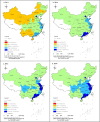Coupling coordination evaluation and driving path of digital economy and carbon emission efficiency in China: A fuzzy-set qualitative comparative analysis based on 30 provinces
- PMID: 37883359
- PMCID: PMC10602363
- DOI: 10.1371/journal.pone.0287819
Coupling coordination evaluation and driving path of digital economy and carbon emission efficiency in China: A fuzzy-set qualitative comparative analysis based on 30 provinces
Retraction in
-
Retraction: Coupling coordination evaluation and driving path of digital economy and carbon emission efficiency in China: A fuzzy-set qualitative comparative analysis based on 30 provinces.PLoS One. 2025 Aug 25;20(8):e0330563. doi: 10.1371/journal.pone.0330563. eCollection 2025. PLoS One. 2025. PMID: 40853886 Free PMC article. No abstract available.
Abstract
Enhancing the level of coupling coordination between the digital economy (DIE) and carbon emission efficiency (CEE) is not only an inevitable choice for achieving the goals of energy conservation and emission reduction and promoting green development in China, but also a key path to implementing China's "Double Carbon" strategy. Based on the relevant statistical data of 30 provincial-level regions in China from the period covering 2011 to 2019, this paper empirically analyzed the coupling coordination between the DIE and CEE and its influencing factors. In this study, an improved coupling coordination degree (CCD) model was used to evaluate the degree of the coupling and coordinated development of the DIE and CEE in provincial regions of China. Finally, based on the Technology-Organization-Environment (TOE) framework, a fuzzy-set qualitative comparative analysis (fsQCA) method was employed to identify the realization path of the coupling and coordinated development of the DIE and CEE from the perspective of configuration. The results demonstrated that the coupling coordination between the DIE and CCE in China demonstrated a gradual upward trend, and exhibited regional differences, showing a decreasing trend of east > middle > west. Regarding the influencing factors, no single influencing factor could act as a necessary condition for the high CCD, the coupling and coordinated development of the DIE and CEE is a multifactorial synergy. There were five paths for the high degree of coupling coordination between the DIE and CEE, which were divided into three types: organization-environment-led type, environment-led type, and technology-organization-led type. Furthermore, technological innovation level and industrial structure could substitute for one another in some conditions, and environmental regulation and economic development level were synchronized. These conclusions provide a theoretical basis for countries to formulate policies to promote the coupling and coordinated development of their DIE and CEE.
Copyright: © 2023 Li et al. This is an open access article distributed under the terms of the Creative Commons Attribution License, which permits unrestricted use, distribution, and reproduction in any medium, provided the original author and source are credited.
Conflict of interest statement
The authors have declared that no competing interests exist.
Figures
Similar articles
-
[Spatiotemporal Characteristics and Configuration Paths of the Coupling Coordinated Development between Digital Economy and Green Logistics under the Background of "Dual Carbon"].Huan Jing Ke Xue. 2025 Jul 8;46(7):4159-4174. doi: 10.13227/j.hjkx.202405286. Huan Jing Ke Xue. 2025. PMID: 40677038 Chinese.
-
Prescription of Controlled Substances: Benefits and Risks.2025 Jul 6. In: StatPearls [Internet]. Treasure Island (FL): StatPearls Publishing; 2025 Jan–. 2025 Jul 6. In: StatPearls [Internet]. Treasure Island (FL): StatPearls Publishing; 2025 Jan–. PMID: 30726003 Free Books & Documents.
-
Coupling coordination and future pathways forecasting of circular economy, green financial strategies and carbon emissions: A provincial level assessment.J Environ Manage. 2025 Sep;392:126696. doi: 10.1016/j.jenvman.2025.126696. Epub 2025 Jul 28. J Environ Manage. 2025. PMID: 40730016
-
[Volume and health outcomes: evidence from systematic reviews and from evaluation of Italian hospital data].Epidemiol Prev. 2013 Mar-Jun;37(2-3 Suppl 2):1-100. Epidemiol Prev. 2013. PMID: 23851286 Italian.
-
Home treatment for mental health problems: a systematic review.Health Technol Assess. 2001;5(15):1-139. doi: 10.3310/hta5150. Health Technol Assess. 2001. PMID: 11532236
Cited by
-
Coupling coordination analysis of the economic-social-infrastructure-ecological resilience system: A case study of Zhejiang Province.PLoS One. 2025 May 21;20(5):e0323673. doi: 10.1371/journal.pone.0323673. eCollection 2025. PLoS One. 2025. PMID: 40397885 Free PMC article.
-
Spatiotemporal trends and coordination of agricultural carbon efficiency in the Yangtze River Economic Belt and Yellow River Basin, China: An analysis of influencing factors and green finance integration.PLoS One. 2024 Aug 29;19(8):e0308399. doi: 10.1371/journal.pone.0308399. eCollection 2024. PLoS One. 2024. PMID: 39208333 Free PMC article.
-
Retraction: Coupling coordination evaluation and driving path of digital economy and carbon emission efficiency in China: A fuzzy-set qualitative comparative analysis based on 30 provinces.PLoS One. 2025 Aug 25;20(8):e0330563. doi: 10.1371/journal.pone.0330563. eCollection 2025. PLoS One. 2025. PMID: 40853886 Free PMC article. No abstract available.
References
-
- Cheng Y, Zhang Y, Wang J, Jiang J. The impact of the urban digital economy on China’s carbon intensity: Spatial spillover and mediating effect. Resour Conserv Recycl. 2023;189:106762. doi: 10.1016/j.resconrec.2022.106762 - DOI
-
- Report on the Development of China’s Digital Economy.: China Academy of Information and Communications Technology.2022.
-
- Sun W, Huang C. How does urbanization affect carbon emission efficiency? Evidence from China. J Clean Prod. 2020;272:122828. Epub 2020-01-01. doi: 10.1016/j.jclepro.2020.122828 - DOI
-
- Irfan M, Elavarasan RM, Hao Y, Feng M, Sailan D. An assessment of consumers’ willingness to utilize solar energy in China: End-users’ perspective. J Clean Prod. 2021;292:126008. doi: 10.1016/j.jclepro.2021.126008 - DOI
-
- Cao S, Nie L, Sun H, Sun W, Hesary FT. Digital finance, green technological innovation and energy-environmental performance: Evidence from China’s regional economies. J Clean Prod. 2021;327:129458. doi: 10.1016/j.jclepro.2021.129458 - DOI
Publication types
MeSH terms
Substances
LinkOut - more resources
Full Text Sources





